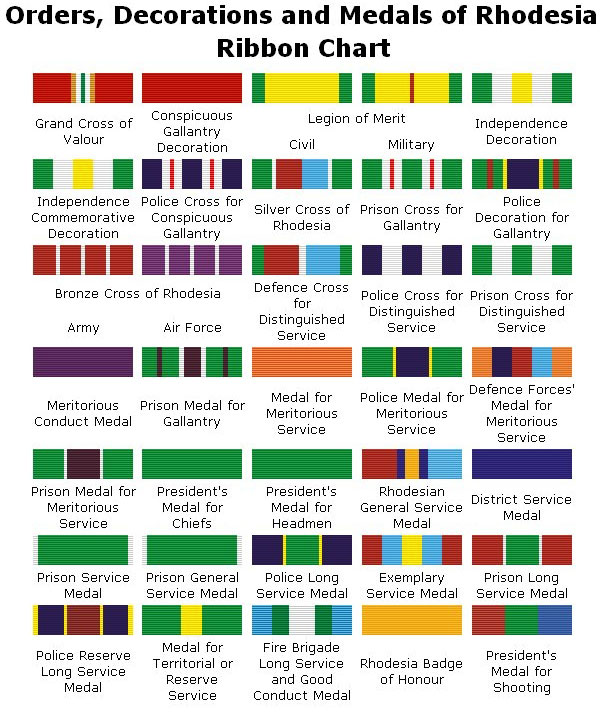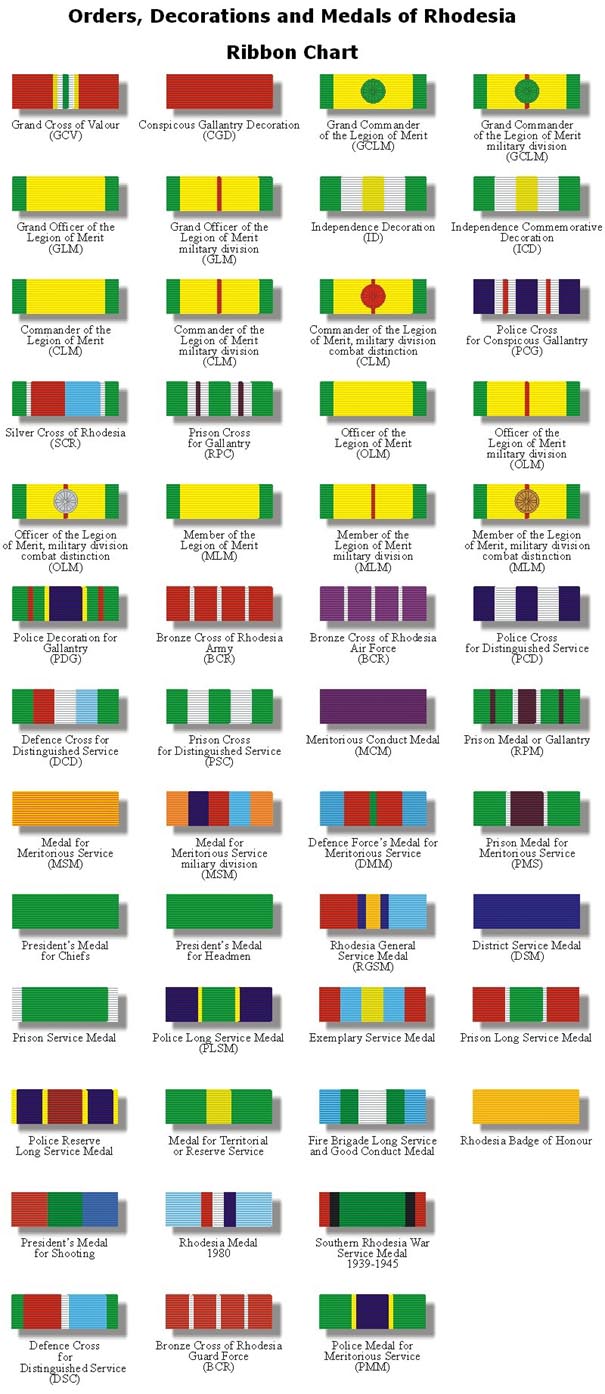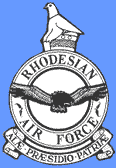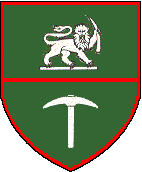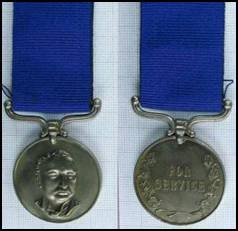THE HISTORY OF RHODESIAN HONOURS AND AWARDS
1890-1980
by JOHN VOLLAIRE (For the MEDALS, click here.)
(For the MEDALS, click here.)
With the exception of the awards of the VICTORIA
CROSS, all extracts in this series have been taken at random from
Volumes 1 to 5 of The History of Rhodesian Honours and Awards 1890-1980.
During the Rebellion of 1896 three Victoria Crosses were
awarded - all
to Rhodesians. Two of these are of particular interest. One being the
first awarded on Rhodesian soil and the first to a Rhodesian. The
second was a posthumous award Gazetted nearly eleven years after the
event.
For the purpose of this article the extracts are, in most
cases, in
edited form - for reasons of space - and details the Awards earned by
Rhodesians, and other Nationals who fought by their side, throughout
the many conflicts in which they took part. Commencing with the
Matabele War of 1893 and progressing through the South African War of
1899-1902, the two World Wars, Malaya etc, to the 'Final Conflict' of
the Bush War which saw the demise of Rhodesia in 1980.
The cases are many and varied and range throughout the whole
spectrum
of awards. From the Civil Lists and those who received the highest
accolade for chivalry and bravery to those who only received the
General Service Medal and represented a small cog in a large machine
but, without whom, that machine would not have functioned as
efficiently as it did.
On the 11th November 1965, the Rhodesian Government
unilaterally
declared the country's independence from Great Britain and, shortly
afterwards, instituted a new list of Honours and Awards. It is a sad
fact that only nine of these awards bear the name Rhodesia.
Unfortunately, the Rhodesia General Service Medal - of which more than
twenty thousand were awarded - is not one of them. I have received
literally hundreds of letters from individuals all over the world who
only received this medal. However, it is their record and background
that has proved to be more fascinating than one might imagine, which
only goes to bear out my contention that there is far more hidden
behind the RGSM than appears on the surface. Details which, for reasons
of space, would not normally be included in a Unit History.
As in all wars, there have been numerous incidents of self
sacrifice
and acts of gallantry which have gone unnoticed and unrecorded. In this
respect the Rhodesian Bush War was no exception. Rhodesia was not
overly generous with her awards and there were many who, perhaps in
other circumstances, would have received recognition. U Gen G P Walls,
in his forward to Dr Paul Moorcroft's book, 'CONTACT 2', paid this
tribute, in part, "...nothing can detract from the story of the men and
women who fought the gallant fight, in uniform or out of it, paid or
unpaid, 'gonged' or taken for granted...".
THE FIRST VICTORIA CROSS
As we have seen in the previous chapters the Matabele were a
force to be reckoned with and although they had outwardly submitted,
with fairly good grace after the war of 1893, the major part of their
Impis had not been tested in the field. Beneath this outward good grace
was a feeling of humiliation and frustration.
On the 29th December 1895, Dr Jameson, had, as a result of
his abortive
'raid' into South Africa from Pitsani with its disastrous consequences,
virtually stripped the white population in Rhodesia of its Police Force
and principle weaponry, thus leaving the Pioneers in a precarious
position in the possible event of trouble.
When news of this disaster filtered through, the smouldering
Matabele
were deluded into a belief that their time had come and they rose, with
the usual terrible accompaniment of murder and rapine.
The first incident took place on the night of Friday 20th
March, 1896,
with the murder of a native policeman. This was followed on the 23rd by
the slaughter of the Cunningham family, three generations of which fell
to the stabbing assegais and battle-axes of the Matabele.
News of the rebellion quickly reached Bulawayo and a hasty laager of
wagons was drawn up in the town square.
Captain Selous brought his wife in with him from Essexvale
and
immediately set about raising a mounted force of thirty-six men, all
that could be armed and horsed. This formed the nucleus of what was to
be known as H Troop, Bulawayo Field Force.
According to Selous, there were only five hundred and eighty
rifles
belonging to the Government in the whole of Rhodesia when the rebellion
commenced, with a few machine guns at Bulawayo; the horse supply was
virtually non-existent due to the rinderpest, the food supply was low
and they were faced with more than ten thousand Matabele, many of whom
were armed with Martinis and muzzle-loaders.
Several volunteer troops were rapidly raised, or united on
the spur of
the moment and these consisted of the Grey's Scouts, Gifford's Horse
and the Rhodesia Horse.
There were more than six hundred women and children in
Bulawayo alone,
and prompt action was a matter of top priority for their protection and
the relief of many more scattered about the land in lonely farms and
isolated stations.
To add to the authority's problems, the native police
deserted to the
enemy with their Winchester repeaters. The telegraph wires had also
been cut, thus effectively isolating them from the rest of the country.
In the first few weeks of the up-rising many lonely
prospectors were
caught unawares and unspeakably put to death and whole families were
surprised, raped, tortured and butchered.
Many of them however, finding themselves surrounded and outnumbered,
fought to the last taking many of the enemy with them. Standing out in
bold relief against the background of slaughter are many incidents of
rare heroism and bravery. The West brothers for instance, both former
members of the Bechuanaland Border Police, in their splendid, but
hopeless, defence in their store at far-off Thabas Amamba, fought with
true British grit and kept the enemy at bay for ten long hours falling
at last surrounded by a pile of dead Matabele. Or the story of the
German family on the Shangani where the Matabele having killed the old
farmer and his wife, dragged the bodies out of the house and after
leaving them before the door took up an ambush position in a nearby
kopje to await the return of the rest of the family. The youngest son,
a lad of sixteen, who was staying with his parents whilst his older
brother rode transport, was out shooting at the time. Suspecting
nothing, as news of the rising had not yet reached this remote area, he
noticed on his return that the house looked deserted. On closer
inspection he was horrified to find the dead bodies of his parents in
front of the house.
Sighting the movement of the Matabele, he took up a defensive
position
on a granite ledge and calmly awaited their coming. A band of thirty
warriors rushed him. With cool precision he opened fire accounting for
fourteen of the enemy before the remainder took to flight. The danger
over, the young lad proceeded to where his dead parents lay and was
preparing to bury them when a Matabele crept up from behind and killed
him with a battle-axe. This was taken from an eye-witness account and
is given in detail in Frank W Sykes' book, 'With Plumer in
Matabeleland'.
This then, was the scenario all over Matabeleland.
TROOPER HERBERT STEPHEN HENDERSON, VC
On Saturday 27th March 1896, news was received in Bulawayo
that seven white men were surrounded by the Matabele at Inyati, a post
some 15 miles (24km) north-east of the Queen's Mine and 50 miles (80km)
north of Bulawayo. A small party of eleven men under Captain
Pittendrigh of the Africander Corps rode out of Bulawayo just before
midnight to rescue the trapped men, first stopping at Jenkin's Store
and then on to relieve Mr Graham, the Native Commissioner in Inyati.
Finding all was quiet at Jenkin's Store, the party, now
raised to
nineteen, pushed on through the bush to relieve Mr Graham. They were
riding through the Elibaini Hills when they were attacked by a strong
detachment of Matabele armed with assegais and rifles. Two men were
wounded before the patrol managed to throw off the attackers and made
for Campbell's Store across the Bembesi, where they learned that Mr
Graham, Sub-Inspector Hanley and four miners had been massacred after
holding out against overwhelming odds.
As the area was swarming with warriors, mainly from the crack
Ingubo
Regiment, they decided to fortify the store. They had about two
thousand rounds of ammunition and felt that they could withstand a
night attack. Two men, Fincham and Mostert, were sent back to Bulawayo
by another route for reinforcements, and got away safely.
That night, Sunday 28th March, a second stronger patrol,
under the
command of Captain MacFarlane, left Bulawayo to effect a rescue. This
consisted of thirty horsemen; fifteen from the Africander Corps under
Commandant van Rensburg and Captain van Niekerk and the remainder from
the Rhodesia Horse volunteers.
Riding through the night with only a brief halt at Queen's
Reef Mine,
they pushed on to Campbell's Store. Heading the patrol as scouts and
advance guards, at a distance of some 300 yards (270m), were Troopers
Celliers and Henderson.
Trooper Henderson, a 26 year old mine engineer, had
volunteered earlier
to ride from Queen's Reef Mine to Bulawayo for help. For protection on
this perilous ride he had been given a revolver and one cartridge, all
that was available.
In the early hours of the morning of Monday the 29th, the
patrol was
attacked in dense bush about 5 miles (8km) from Campbell's Store. The
Matabele opened fire at close range and although the darkness and thick
bush favoured the Matabele the accurate return fire from the patrol
enabled them to fight their way through the ambush. A running fire
which lasted for half an hour.
Finally emerging from the bush at dawn, the patrol rode
across the open
veld and dashed up the river bank to the store to the relieved cheers
of the beseiged men.
It was only then that it was realised that Troopers Celliers
and
Henderson were missing.
Celliers and Henderson had been well ahead of the main body when the
Matabele sprang the ambush. Celliers was shot through the knee and his
horse hit in five places. Subjected to heavy fire and effectively cut
off from the main party the two men swung their horses off the track
and headed into the dense bush. After a wild gallop lasting a few
minutes they reined in their horses. Sporadic firing could still be
heard above the shouting of the Matabele.
Celliers' horse finally collapsed from its wounds. Henderson
dismounted, lifted the injured Celliers onto his own horse and taking
the reins led it away from the noise of battle. Celliers, in great
pain, and suffering from loss of blood appealed to Henderson to leave
him. It would be suicidal, he reasoned, to try to walk to Bulawayo.
Rather that one should die than both. Henderson refused to listen.
Ahead lay 35 miles (56km) of rough country thick with marauding bands
of fierce Matabele.
As dawn was breaking, Henderson led the tired horse carrying
the
swaying Celliers into thick bush where he treated the injured man's
wound as best he could. They had no food with them but managed to catch
some sleep although they were unpleasantly close to some Matabele
encampments.
For two days and two nights Henderson trudged through the
bush leading
the horse carrying his injured companion. Both were suffering from
hunger and Celliers was in intense agony. On Tuesday the 30th
(Henderson's birthday), they hid in the hills. Never, he said later,
did he want to spend another birthday like that again. That night,
Henderson had to exercise extreme caution as he weaved his way through
the Matabele impis which encircled Bulawayo.
On Wednesday morning a bone-weary Henderson walked into
Bulawayo with
his faithful horse and injured companion.
Celliers had his leg amputated and he died in hospital on the
16th May
1896.
At a general parade called by Earl Grey on the 3rd June, he
referred,
in his address, to Henderson's gallant conduct and brave feat.
Captain MacFarlane, the leader of the patrol, wrote a letter
to the
Administrator of the British South Africa Company, recommending
Henderson for the award of the Victoria Cross. As all communication
with Salisbury had been cut, the letter was forwarded to Cape Town and
from there to London.
The award of the Victoria Cross (the first won on Rhodesian
soil) to
Henderson was gazetted on the 7th May 1897. The citation was drawn from
the letter written by Captain MacFarlane. Trooper Henderson was
decorated by Lord Milner at the opening of the Bulawayo Railway on the
4th November 1897.
Trooper Herbert Stephen HENDERSON was born at Hillhead,
Glasgow, on the
30th March 1870. The fourth son of William Henderson, Bishop Street
Engineering Works, Glasgow and grandson of James Henderson,
shipbuilder, Glasgow. Educated at Kelvinside Academy, Hillhead, Glasgow
and served his apprenticeship with J and J Thomson Engineers, Glasgow.
He then moved to Belfast where he worked for Harland and Wolff. In 1892
he left for the Rand in South Africa where he was connected
professionally with the Langlaagte, Primrose, Croesus and George and
May Gold Mines. Two years later he moved to Rhodesia where he became
the engineer of the Queen's Mine. When the Matabele rebellion broke out
he joined the Bulawayo Field Force, initially as a scout, and served as
a gunner in the Artillery Troop.
Henderson remained in the gold-mining industry for some years
and was,
at one stage, the timber contractor to the Globe and Phoenix goldmine.
He later prospected for the German Administration in South West Africa.
During the First World War, Henderson was not permitted to
leave
Rhodesia on active service, as gold-mining was considered an essential
service. In 1924 he married Helen Joan Davidson. They had two sons,
Alan Stephen Accra in 1926 and Ian Montrose in 1927.
For the duration of the Second World War, Henderson had all
profits
from the Prince Olaf Mine given to the War Fund.
He died of a duodenal ulcer on the 10th August 1942 and was
buried in
the Bulawayo cemetery. His grave number is 887. The grave is otherwise
unmarked, apart from the number.
CITATION
London Gazette, May 7th 1897: "H S Henderson, Bulawayo Field Force. On the morning of the 30th March 1896 just before daylight Captain MacFarlane's party was surprised by the natives. Troopers Celliers and Henderson, who formed part of the advance guard, were cut off from the main body and Celliers was shot through the knee. His horse was badly wounded, and eventually died. Henderson then placed Celliers on his own horse and made the best of his way to Bulawayo. The country between Campbell's Store, where they were cut off, and Bulawayo (a distance of about 35 miles) was full of natives fully armed and they had, therefore, to proceed principally by night, hiding in the bush in the daytime. Celliers, who was weak from loss of blood and in great agony, asked Henderson to leave him, but he would not, and brought him in, after passing two days and one night in the veld without food."
ORDERS, DECORATIONS AND MEDALS
Victoria Cross (Bulawayo Field Force), BSA Company Medal, 1896, for Rhodesia (Artillery Troop, Bulawayo Field Force).
ACKNOWLEDGEMENTS
PRINCIPLE RESEARCHERS: Elizabeth and Graham Colhurst-Freymuth.
Principle works consulted and from which information has been extracted:
CREAGH, Sir O'Moore, VC, GCB, GCSI and E M Humphris (eds). "The
Victoria Cross 1856-1920" (originally published 1920 as Vol 1 of "The
VC and the DSO"), J B Hayward & Son reprint (Polstead, Suffolk,
1985).
GALE, WD, "One Man's Vision", Rhodesiana Reprint Library -
Silver
Series, Vol 12 (Books of Rhodesia, Bulawayo 1976)
.
PARRY, DH, "The VC, its Heroes and Their Valour", (Cassell &
Company Ltd, London).
REGISTER, "The Register of the Victoria Cross", This England Books
(Chettenham, Glos, 1981).
SYKES, Frank W, "With Plumer in Matabeleland", Rhodesiana
Reprint
Library, Vol 21, (Books of Rhodesia, Bulawayo, 1972).
UYS, Ian S, "For Valour: The Story of Southern Africa's VC
Heroes". Ian
S Uys, (Johannesburg, 1973).
RECORDS CONSULTED:
Colonial Office Papers; Folios 7 to 554B and 560.
War Office Papers: Folios 32/8546.
Treasury to War Office Papers: T.1/9165A/11007.
British South Africa Company to Colonial Office Papers.
British South Africa Company to War Office Papers.
High Commissioner for South Africa to Colonial Office Papers.
Major General Sir F Carrington to Colonial Office: 652/98 (from
Gibraltar).
Rhodesian Honours and Awards 1965 - 1980
Shortly after the Rhodesian Government declared Unilateral
Independence from England in 1965 the new government instituted its own list of of Honours and Awards, depicted here.
The first picture is of those of Higher Order, and then all are individually described.
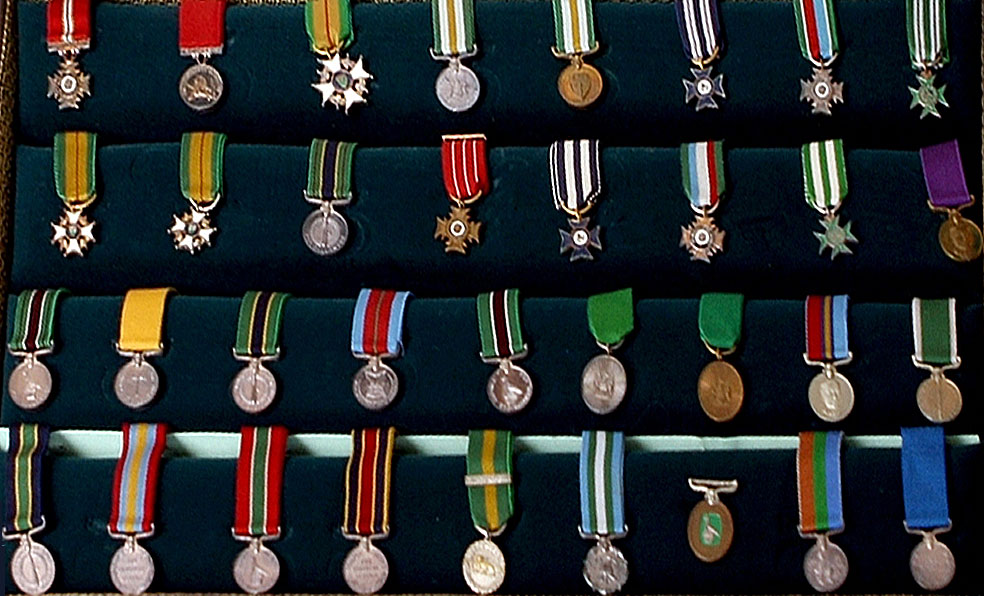
| 1 |
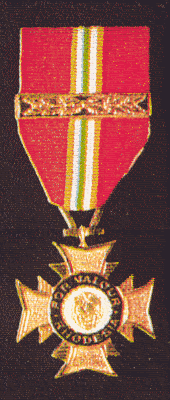 |
The Grand Cross of Valour (G.C.V) For conspicuous valour by members of the Security Forces in combat. This is Rhodesia's highest award for gallantry and as such heads the order of presidence.
Recipients have the right to wear the ribbon of the award in their buttonhole.
Shape: Maltese Cross; metal: 9ct gold: diameter: 38mm;
|
| 2 | 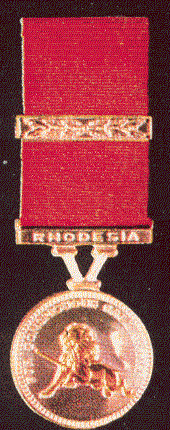 |
Conspicuous Gallantry Decoration(C.G.D.) For acts of the highest gallantry and brave conduct of an outstanding order in a non-combatant capacity. This award may be made to civilians and members of the Security Forces and as the second highest award for gallantry will rank next to the Grand Cross of Valour in the order of precedence. |
| 3 | 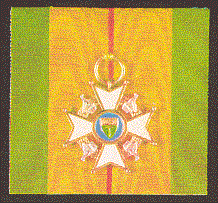 |
Grand Commander of the Legion of Merit (G.C.L.M.) For outstanding service to Rhodesia. On formal occasions a sash, badge and gold star will be worn. Grand Commander of the Legion of Merit (G.C.L.M.) (Military Division) |
| 4 | 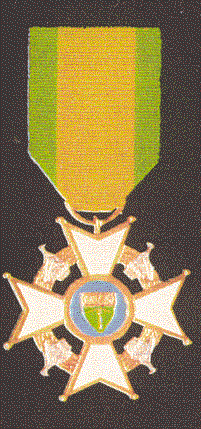 | Grand Officer of the Legion of Merit (G.L.M.) For outstanding service to Rhodesia. A silver star and neck badge to be worn on formal occasions. |
| 5 | 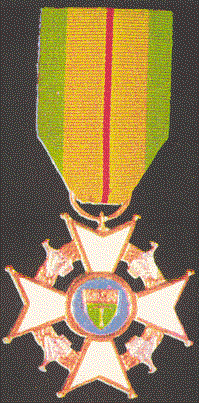 |
Grand Officer of the Legion of Merit (G.L.M.) (Military Division) For outstanding service to Rhodesia. A silver star and neck badge to be worn on formal occasions. |
| 6 | 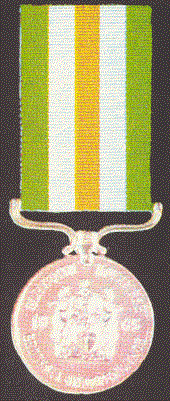 |
Independence Decoration (I.D.) For persons who played a notable and significant part before or at the time of, or immediately succeeding the Declaration of Independence. |
| 7 | 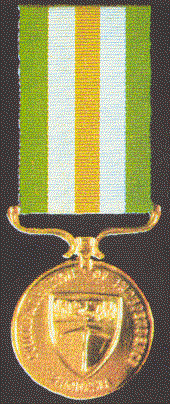 | Independence Commemorative Decoration (L.C.D.) For persons who have rendered valuable service to Rhodesia up to the 2nd March, 1970. This award and that of the Independence Decoration will be worn on the breast. |
| 8 | 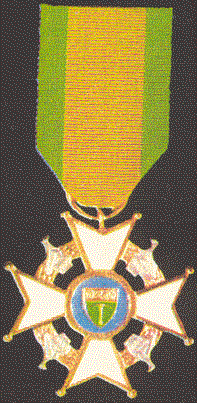 | Commander of the Legion of Merit (C.L.M.) For distinguished service to Rhodesia. A neck-badge will be worn on formal occasions |
| 9 | 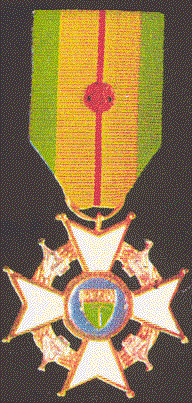 | Commander of the Legion of Merit (C.L.M.) (Military Div.) For distinguished service to Rhodesia. A neck-badge will be worn on formal occasions |
| 10 | 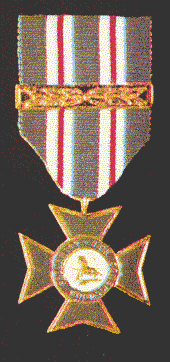 | Police Cross for Conspicuous Gallantry (P.C.G.) For conspicuous gallantry. |
| 11 | 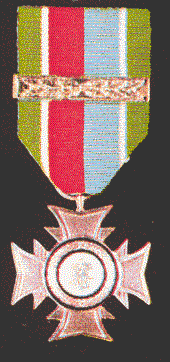 | Silver Cross of Rhodesia (S.C.R.) For conspicuous gallantry. |
| 12 | 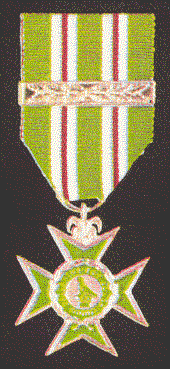 | Prison Cross for Gallantry (R.P.C.) For conspicuous gallantry. |
| 13 | 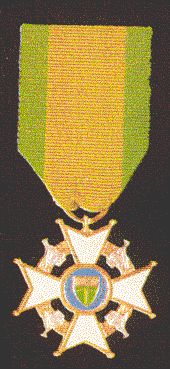 | Officer of the Legion of Merit (O.L.M.) For distinguished service to Rhodesia. This award will be worn on the breast. |
| 14 | 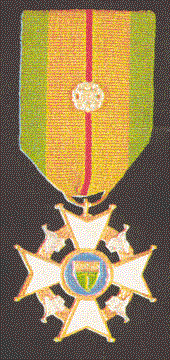 | Officer
of the Legion of Merit For distinguished service to Rhodesia. This award will be worn on the breast. |
| 15 | 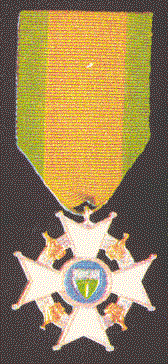 | Member
of the Legion of Merit
(M.L.M.) |
| 16 | 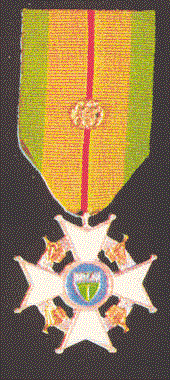 | Member of the Legion of Merit (M.L.M.) (Military Division) For distinguished service to Rhodesia. This award will also be worn on the breast. |
| 17 | 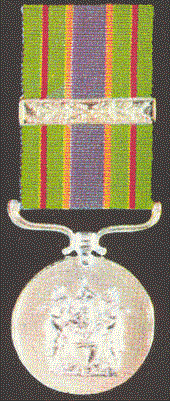 | Police Decoration for Gallantry (P.D.G.) For gallantry |
| 18 | 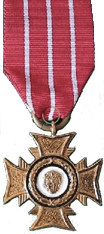 |
Bronze Cross of Rhodesia(B.C.R.) (Army) For gallantry |
| 19 | 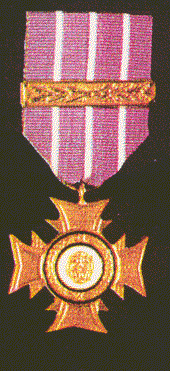 | Bronze Cross of Rhodesia(B.C.R.) (Air Force) For gallantry |
| 20 | 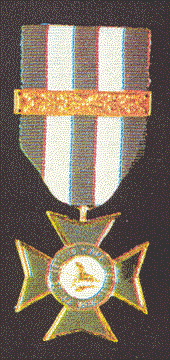 | Police Cross for Distinguished Service (P.C.D.) For distinguished service. |
| 21 | 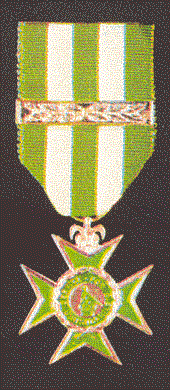 | Prison Cross for Distinguished Service (P.S.C.) For distinguished service. |
| 22 | 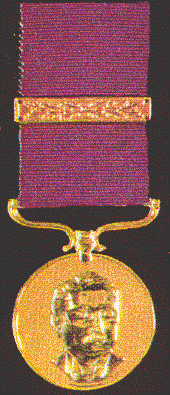 | Meritorious Conduct Medal (M.C.M.) For brave and gallant conduct over and above the call of duty in a non-combatant capacity. The award may be made to both civilians and members of the Security Forces. |
| 23 | 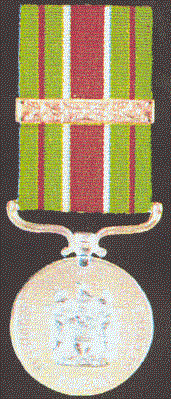 |
Prison Medal for Gallantry (R.P.M.) For gallantry. |
| 24 | 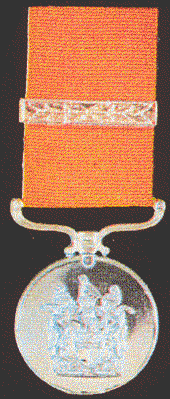 |
Medal for Meritorious Service (M.S.M.) For resource and devotion to duty or exemplary voluntary service to the community. Two divisions: (a) civil division and (b) Security Forces division. Used only for Territorial Force or Reserves |
| 25 |
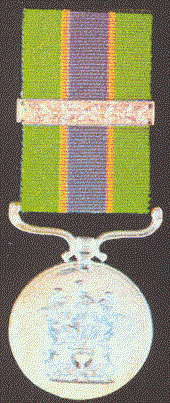 | Police Medal for Meritorious Service (P.M.M.) For meritorious service. |
| 26 | 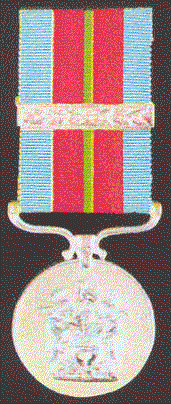 | Defence Forces' Medal for Meritorious Service (D.M.M.) For meritorious service. |
| 27 | 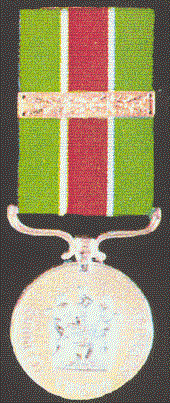 | Prison Medal for Meritorious Service (P.M.S.) For meritorious service. |
| 28 | 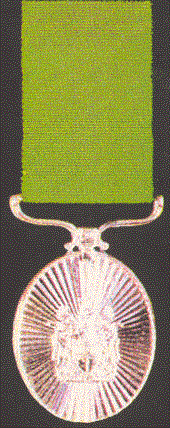 | President's Medals for Chiefs For Chiefs who have rendered conspicuous service in the interests of their people. |
| 29 | 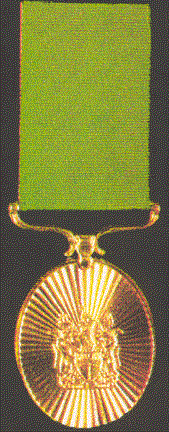 |
President's Medal for Headmen For Headmen who have rendered conspicuous service to their communities over and above the call of duty. |
| 30 | 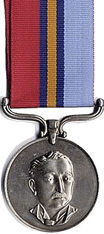 |
General Service Medal For service on operations undertaken for the purposes of combating terrorist or enemy incursions into Rhodesia. |
|
Only awarded to black District Assistants and District Security Assistants. No white member of the Rhodesian Security Forces should have been awarded one unless by complete accident.
|
||
| 31 | 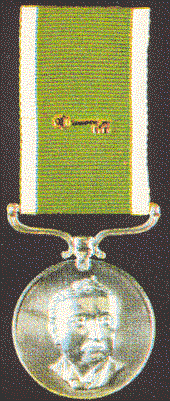 |
Prison Service Medal For the part played in maintaining law and order. |
| 32 | 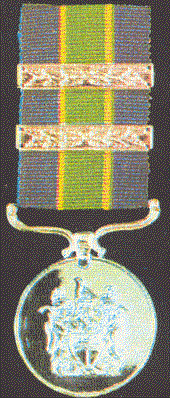 |
Police Long Service Medal For long and exemplary service. |
| 33 | 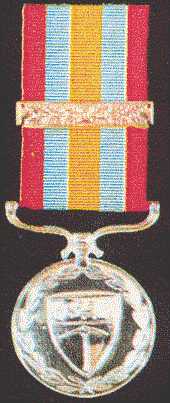 |
Exemplary Service Medal For long and exemplary service. |
| 34 | 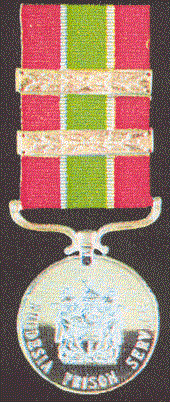 |
Prison Long Service Medal For long and exemplary service. |
| 35 | 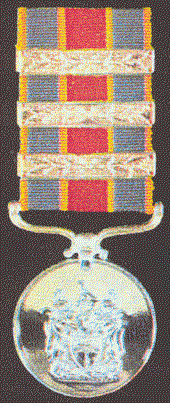 |
Police Reserve Long Service Medal For long and exemplary service. |
| 36 | 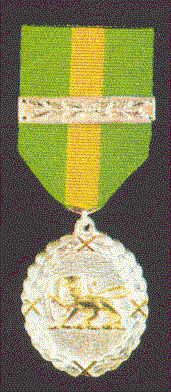 | Medal for Territorial or Reserve Service The
basic qualification for this medal will be nine
years' voluntary service in the "A" Reserve, or fifteen years' service
in the field reserve. |
| 37 | 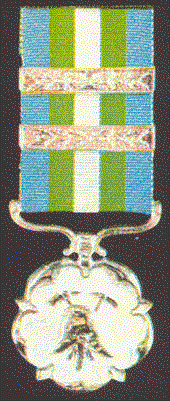 | Fire Brigade Long Service and Good Conduct Medal For long service in a Fire Brigade. |
| 38 | 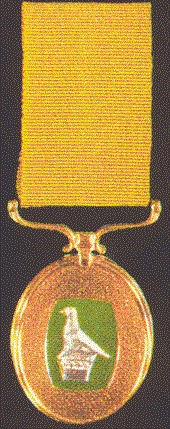 | Rhodesia Badge of Honour For long service and devotion to duty in Government, Municipal or private service. |
| 39 | 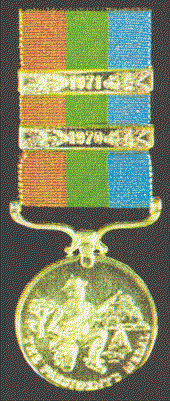 | President's Medal for Shooting To be awarded to the champion shot of the Security Forces. |
| 40 | 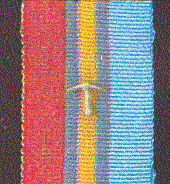 |
Military Forces' Commendation
(As shown on 30). A silver or bronze pick emblem to denote an act of bravery, distinguished service, or continuous devotion to duty in the operational or non-operational sphere. This emblem will either be displayed on the ribbon of the appropriate General Service or Campaign Medal or will be sewn on the tunic immediately following other awards. Otherwise it will be displayed in a central position on the left breast where a ribbon would be worn. |
| 41 | Commissioner's Special Commendation and Commissioner's Commendation (Police)
Will be marked respectively by a silver or bronze truncheon emblem to denote acts above the call of duty under operational or non-operational conditions. Will be worn on the top of the left pocket flap below medal ribbons. |
|
| 42 | 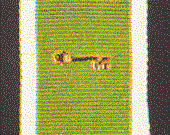
|
Director's Commendation (Prisons).
(As shown on 31). To be marked by a bronze key emblem worn in the manner of the Military Forces Commendation. |
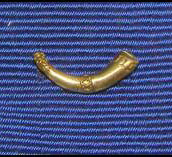 |
The Intaf Commendation emblem (device) on DSM ribbon. This was Intaf’s equivalent of the Military Forces Commendation (pick) and BSAP’s Commissioner’s Special Commendation (baton) and British Mentioned in Dispatches (MID). It depicts an ancient war horn known as an "oliphant". The same emblem is on the badge Intaf wore on their headgear. White members of Intaf who were awarded the commendation, wore it on their Rhodesian General Service Medal ribbon. |
|
NOTES:
1. The official order of precedence for all honours and awards shall be as follows:
(i) Rhodesian orders, decorations and medals.
(ii) Foreign orders, decorations and medals in this order and by date of their award.
2. Bars may be awarded where appropriate and will be attached to the
ribbon when the medal is worn. When ribbons only are worn a bar will be
indicated by a small silver rosette attached to the centre of the
ribbon or by a miniature replica of the award where applicable.
3. The following coloured rosettes will be worn in the centre of the
under mentioned ribbons in order to distinguish thern from the other
ribbons of the same pattern:
I.D. — Green to distinguish this award from the I.C.D. On ribbon only.
G.C.L.M. Green to distinguish this award from other classes of the Legion of Merit. On ribbon only.
C.L.M. (Military) Red for combat distinction.
O.L.M. (Military) Silver for combat distinction.
M.L.M. (Military) - Bronze for combat distinction.
(For C.L.M., O.L.M. and M.L.M these will be worm on full size and miniature medals and ribbon bar.)
4. Where the initial letters of awards are shown in this order of
precedence, they may be used after the name of the recipient.
Note:
Medals 4,5,8 and 9 in the illustrations are worn as
breast medals in miniature, but as a neck badge when full size medals
are worn.
5. The Rhodesian District Service Medal (DSM)
Dudley Wall notes:
“For some unknown reason the Government felt that African members of Intaf in uniform were not eligible for the RGSM (whereas whites were) and therefore brought out the DSM specifically. Ironically many African members of Intaf were ex Rhodesian African Rifles and held the RGSM anyway. I had several ex RAR chaps (and one ex Kings African Rifles medic.) in my ARU Troop and they were awarded both the RGSM and the DSM”
Lewis Walter notes:
“Our DAs and DSAs were in closer and more intimate contact with the terrs than most of the other forces, as well as living full time in operational areas. I cannot understand what contorted thinking from our leaders deprived them of the right to receive the RGSM - something which I know caused them deep hurt”
ORDER OF PRECEDENCE
1. | Grand Cross of Valour | (G.C.V.) |
| 2. | Conspicuous Gallantry Decoration | (C.G.D.) |
| 3. | Grand Commander of the Legion of Merit | (G.C.L.M.) |
| 4. | Grand Officer of the Legion of Merit | (G.L.M.) |
| 5. | Independence Decoration | (I.D.) |
| 6. | Independence Commorative Decoration | (I.C.D.) |
| 7. | Commander of the Legion of Merit | (C.L.M.) |
| 8. | Police
Cross for Conspicuous Gallantry, |
|
| 9. | Officer of the Legion of Merit | (O.L.M.) |
| 10. | Member of the Legion of Merit | (M.L.M.) |
| 11. | Police
Decoration for Gallantry, |
|
| 12. | Police Cross for
Distinguished Service, |
|
| 13. | Meritorious Conduct Medal | (M.C.M.) |
| 14. | Prison Medal for Gallantry | (R.P.M.) |
| 15. | Meritorious
Service Medal, |
|
| 16. | President's Medal for Chiefs. | |
|
17. | President's Medal for Headmen. | |
|
18. | General Service Medal | |
| 19. |
Prison Service Medal |
|
| 20. |
Police Long Service Medal, | |
| 21. | Police
Reserve Long Service Medal, | |
| 22. | Rhodesia Badge of Honour. | |
|
23. | President's Medal for Shooting. |
|
